| Snow Hill
Congregational Church A meeting was held in
September, 1846 to discuss the new project and
contributions and subscriptions were sought. At the
meeting £3,000 was promised and other subscriptions soon
followed. At the beginning of 1847 land was purchased on
Snow Hill from the Duke of Cleveland at £1 per square
yard and the town's leading architect Edward Banks was
engaged to design the new church and Sunday school.
Although 1847 started well, the summer and autumn were
so wet that crops failed and a commercial depression
followed. This led to difficulties with the new project
and the Rev. W.H. Heuderbourck, lacking perseverance,
could not face them. He quickly resigned and moved to
Mount Tabor Chapel in St. James' Street. Luckily the
other church members were made of stronger stuff and
continued without him. By the middle of 1848 the Snow Hill Sunday school was
completed and opened on July 4th. The two story building
included 12 classrooms on the top floor to be used for
religious instruction for the elder scholars, without
any disturbance from the children in the schoolroom
below.
To celebrate the opening a tea-meeting was held
on the first floor, during which the floor in the centre
of the room began to sink into a six inch deep
depression. Everyone quickly moved away from the centre
of the room and the floor was quickly propped up from
below. As a result the beams beneath the floor were
strengthened to prevent this happening again. The total
cost of the land and buildings at Snow Hill amounted to
£8,562. |
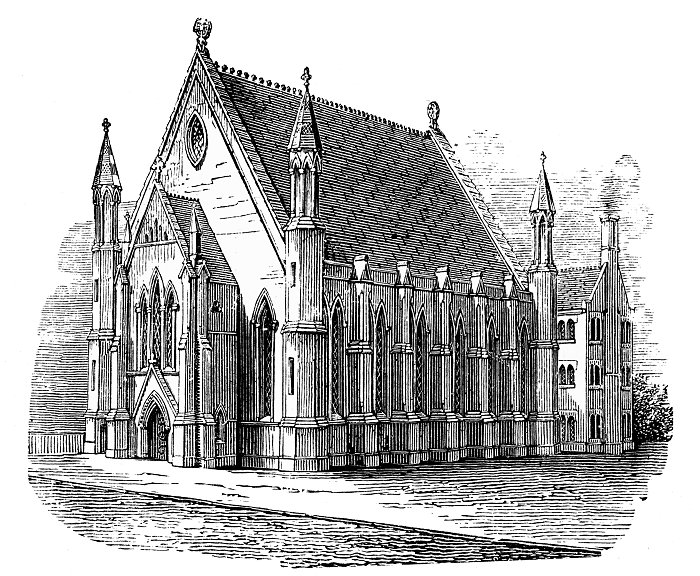
Snow Hill Congregational Church. From “Congregational
Churches of Wolverhampton, 1662-1894” by W. H. Jones. |
|
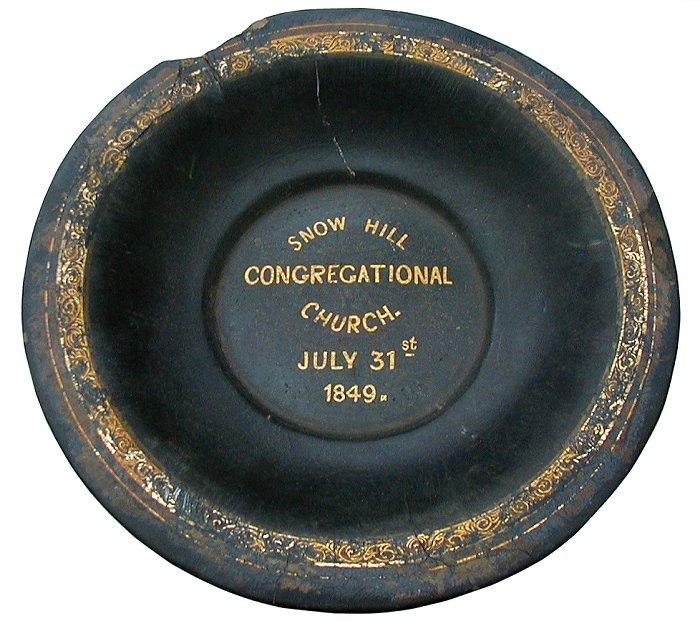
A papier-mâché
plate from the church. Courtesy of Lawson
Cartwright. |
| Snow Hill Congregational Church opened on 31st July,
1849 and the Rev. William Bevan was appointed as pastor.
The old Temple Street chapel became a day school and
continued in use for many years. Reverend Bevan
introduced a new type of service, similar to that used
in the Church of England. Worshippers were asked to
kneel during prayers and to stand to chant a psalm, all
very different to the traditional nonconformist service
where people would stand and turn their backs to the
pulpit during prayer and not chant psalms. |
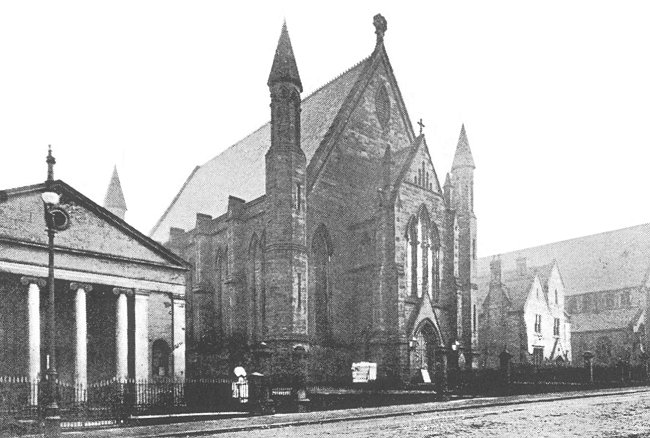
Snow Hill Congregational Church.
Some of the older members refused to follow the new
practice and some even published a pamphlet ridiculing
the new ideas. In the fullness of time however, the new
ideas were accepted by all and William Bevan's merry
smile and warm personality attracted many newcomers. The
church became a fashionable place of worship for some of
Wolverhampton's leading families and a long line of
waiting carriages on Snow Hill was a common sight during
services. Even so the poorer families were not forgotten
and many received regular visits from Reverend Bevan.
One of the most successful parts of the church was the
Sunday school where many received their education. Much
of this success was due to the school superintendent
John Barker, who at the time ran the Chillington Iron
Company's works in Wolverhampton. Things went well at
the church until Mr. Barker's death in 1852. Much of the
money for the new building had been borrowed and £1,500
still had to be paid. Mr. Barker's standing in the
community gave subscribers much confidence but on his
death this disappeared and many subscribers failed to
fulfil their promises. |

The Reverend William Bevan. From
“Congregational
Churches of Wolverhampton, 1662-1894” by W.H. Jones. |
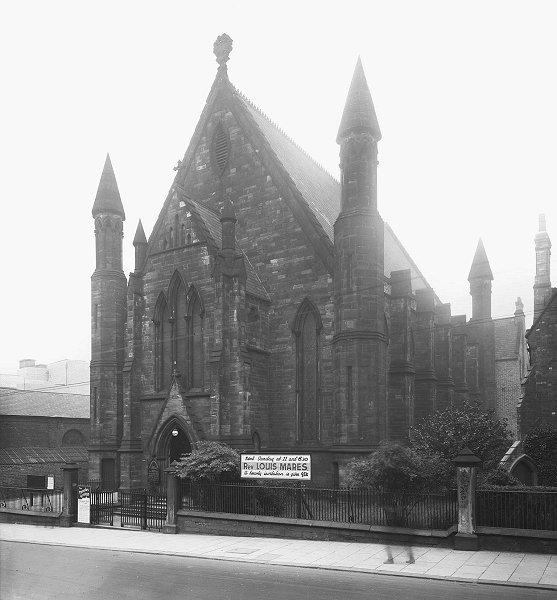 |
Snow Hill
Congregational Church.
From a church
leaflet. |
This caused great anxiety at the church and because
of the unpaid debt, many of the leading families left
the church and worshipped elsewhere. The annual interest
on the loan was charged at 4¾ percent and it took 14
years to complete payment.
Mr. Bevan resigned in 1860 due to ill health and was
replaced by Reverend J. Parnell Palmer who served until
1864. Some of the other ministers at Snow Hill were as
follows:
| |
|
1865 - 1872.
1872 - 1875.
1876 - 1881.
1882 - 1886.
1887 - 1893.
1894 - 1916.
1917 - 1921.
1921 - ?
|
William Henry Charlesworth.
F. Sonley Johnstone.
Henry Irving.
Elvery Dothie.
William Henry Addicott.
Charles Frederick Bone.
John George McKenzie.
Eric Russell Thomas. |
In 1868 members of the congregation thought that
something should be done to provide a chapel for the
rapidly increasing population of neighbouring
Blakenhall. This resulted in the opening of a room in
Cobden Lane which soon proved inadequate, and so land
was purchased in Park Street for the building of a
mission chapel. The chapel costing £650 was paid for by
members of the Snow Hill congregation and a Sunday
school added in 1876. |
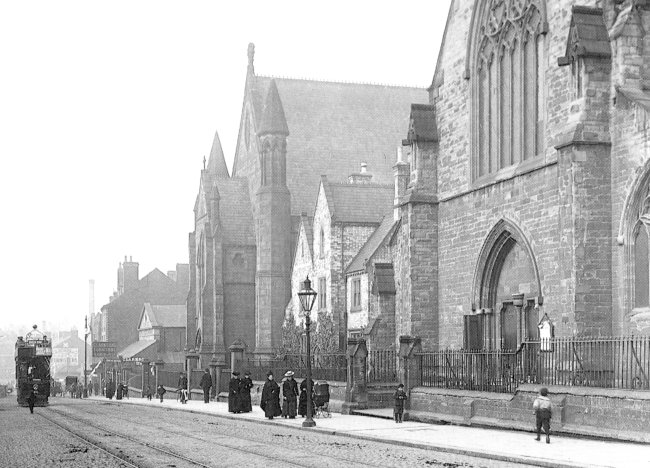
Another view of the church.
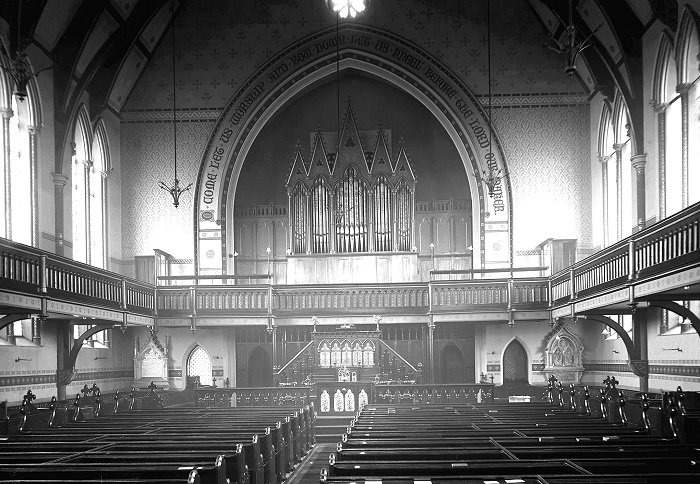
The interior of the church.
During Reverend Sonley Johnstone's ministry the
neighbouring churches at Brewood and Wheaton Aston were
going through difficult times and were without a
minister. Snow Hill Church agreed to form a friendly
alliance with them and supplied lay preachers until a
pastor could be appointed.
In 1876 and 1877 the church was restored and improved. A
new committee room, a ladies vestry and a chapel
keeper's house were added and the interior was decorated
throughout. A few years later improvements were made to
the church heating system to make the building warmer in
the winter, thanks to leading member Joseph Jones.
Around the same time a women's school began to meet on
Monday evenings.
As the end of the century neared, the membership grew
and mid-week prayer meetings, lectures, and bible
classes made the church a busy place. Links were formed
with Merridale Street Mission and the new Congregational
Church at Swan Bank, Penn. Free breakfasts and teas were
provided for the poor and needy, and gifts were given to
the Royal Hospital, and collections made for the widows
and children of those killed in wars.
|
|
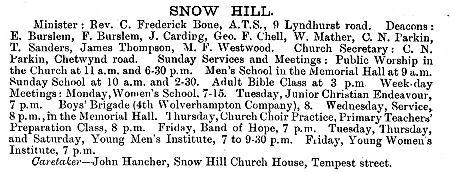
From the Wolverhampton Red book of 1913 |
| By the end of the First World War, the school
building at the rear, facing onto Tempest Street had
been built. It can be seen on the left of the photograph
below, which includes a sign, next to the school
entrance gate, that describes the school as 'Snow Hill
Memorial Hall Adult Schools.'

In 1924 windows of remembrance were installed as part of
the church renovation and many new societies were formed
within the church, such as the Boy's Brigade, the Band
of Hope and the Young People's Guild. Unfortunately
attendances at normal services fell and a visiting
minister summed this up as "a small congregation in a
large church". |
 |
|
 |
|
 |
Return to
The New Chapel |
|
Return to the
beginning |
|
Proceed to
New Beginnings |
|